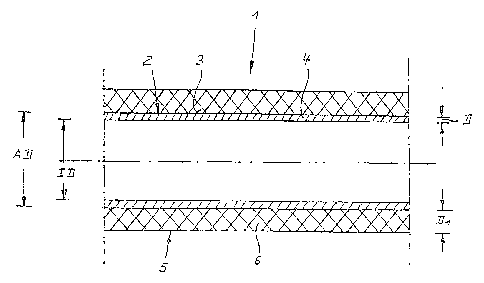Some of the information on this Web page has been provided by external sources. The Government of Canada is not responsible for the accuracy, reliability or currency of the information supplied by external sources. Users wishing to rely upon this information should consult directly with the source of the information. Content provided by external sources is not subject to official languages, privacy and accessibility requirements.
Any discrepancies in the text and image of the Claims and Abstract are due to differing posting times. Text of the Claims and Abstract are posted:
| (12) Patent Application: | (11) CA 2572511 |
|---|---|
| (54) English Title: | CONDUIT FOR CONVEYING MEDIA |
| (54) French Title: | CONDUITE POUR LE TRANSPORT DE MILIEUX |
| Status: | Deemed Abandoned and Beyond the Period of Reinstatement - Pending Response to Notice of Disregarded Communication |
| (51) International Patent Classification (IPC): |
|
|---|---|
| (72) Inventors : |
|
| (73) Owners : |
|
| (71) Applicants : |
|
| (74) Agent: | G. RONALD BELL & ASSOCIATES |
| (74) Associate agent: | |
| (45) Issued: | |
| (86) PCT Filing Date: | 2005-06-30 |
| (87) Open to Public Inspection: | 2006-01-19 |
| Availability of licence: | N/A |
| Dedicated to the Public: | N/A |
| (25) Language of filing: | English |
| Patent Cooperation Treaty (PCT): | Yes |
|---|---|
| (86) PCT Filing Number: | PCT/DE2005/001152 |
| (87) International Publication Number: | WO 2006005297 |
| (85) National Entry: | 2006-12-29 |
| (30) Application Priority Data: | |||||||||
|---|---|---|---|---|---|---|---|---|---|
|
Disclosed is a conduit (1) for conveying media, comprising a core pipe (2)
made of a copper alloy and a jacket (5) made of a plastic from the group
encompassing polyolefins with functional groups. The ratio between the
thickness (D1) of the jacket (5) wall (6) and the thickness of the core pipe
(2) wall (4) ranges between 2:1 and 14:1 while the ratio between the thickness
(D) of the core pipe (2) wall (4) and the inner diameter (ID) thereof ranges
between .01 and .05.
Conduite (1) pour le transport de milieux, qui est composée d'un tube interne (2) constitué d'un alliage de cuivre et d'une gaine (5) constituée d'un plastique appartenant au groupe des polyoléfines à groupes fonctionnels. Le rapport entre l'épaisseur (D1) de la paroi (6) de la gaine (5) et l'épaisseur de la paroi (4) du tube interne (2) est de 2/1 à 14/1 et le rapport entre l'épaisseur (D) de la paroi (4) du tube interne (2) et son diamètre interne (ID) se situe entre 0,01 et 0,05.
Note: Claims are shown in the official language in which they were submitted.
Note: Descriptions are shown in the official language in which they were submitted.

2024-08-01:As part of the Next Generation Patents (NGP) transition, the Canadian Patents Database (CPD) now contains a more detailed Event History, which replicates the Event Log of our new back-office solution.
Please note that "Inactive:" events refers to events no longer in use in our new back-office solution.
For a clearer understanding of the status of the application/patent presented on this page, the site Disclaimer , as well as the definitions for Patent , Event History , Maintenance Fee and Payment History should be consulted.
| Description | Date |
|---|---|
| Time Limit for Reversal Expired | 2011-06-30 |
| Application Not Reinstated by Deadline | 2011-06-30 |
| Inactive: Abandon-RFE+Late fee unpaid-Correspondence sent | 2010-06-30 |
| Deemed Abandoned - Failure to Respond to Maintenance Fee Notice | 2010-06-30 |
| Inactive: Delete abandonment | 2008-07-09 |
| Inactive: Abandoned - No reply to Office letter | 2008-04-14 |
| Letter Sent | 2008-02-06 |
| Inactive: Office letter | 2008-01-14 |
| Inactive: Single transfer | 2007-12-31 |
| Amendment Received - Voluntary Amendment | 2007-08-22 |
| Inactive: Courtesy letter - Evidence | 2007-03-06 |
| Inactive: Cover page published | 2007-03-05 |
| Inactive: Notice - National entry - No RFE | 2007-02-26 |
| Application Received - PCT | 2007-01-31 |
| National Entry Requirements Determined Compliant | 2006-12-29 |
| Application Published (Open to Public Inspection) | 2006-01-19 |
| Abandonment Date | Reason | Reinstatement Date |
|---|---|---|
| 2010-06-30 |
The last payment was received on 2009-06-17
Note : If the full payment has not been received on or before the date indicated, a further fee may be required which may be one of the following
Please refer to the CIPO Patent Fees web page to see all current fee amounts.
| Fee Type | Anniversary Year | Due Date | Paid Date |
|---|---|---|---|
| Basic national fee - standard | 2006-12-29 | ||
| MF (application, 2nd anniv.) - standard | 02 | 2007-07-03 | 2007-06-26 |
| Registration of a document | 2007-12-31 | ||
| MF (application, 3rd anniv.) - standard | 03 | 2008-06-30 | 2008-06-18 |
| MF (application, 4th anniv.) - standard | 04 | 2009-06-30 | 2009-06-17 |
Note: Records showing the ownership history in alphabetical order.
| Current Owners on Record |
|---|
| KM EUROPA METAL AKTIENGESELLSCHAFT |
| Past Owners on Record |
|---|
| CHRISTIAN TRIQUET |
| CHRISTOPH GEYER |
| MATTHIAS KONCZALLA |
| ULRICH REITER |
| WALTER MELCHER |